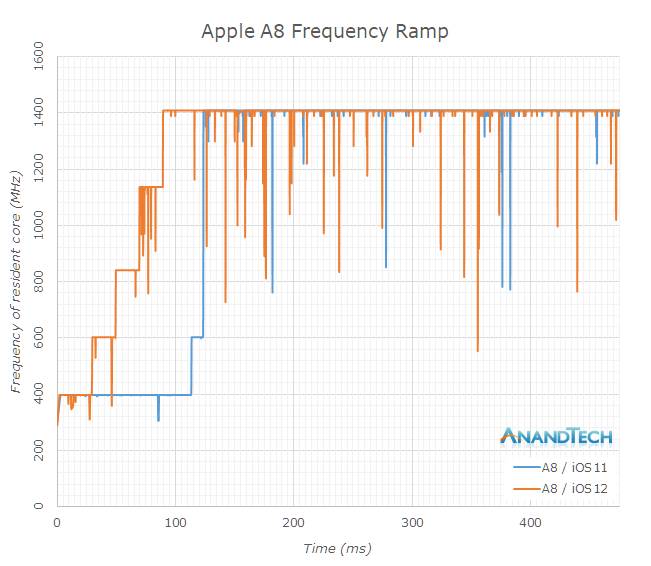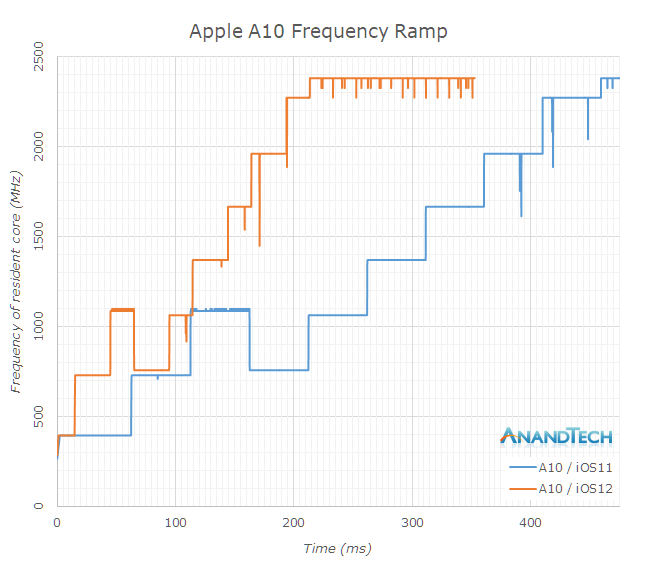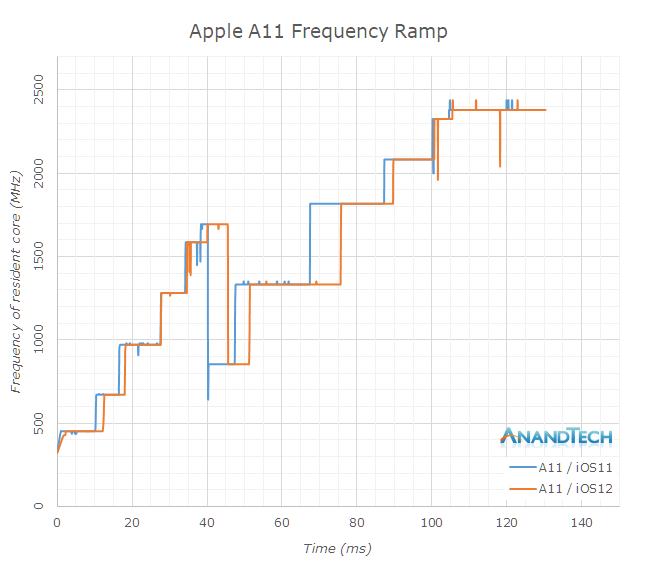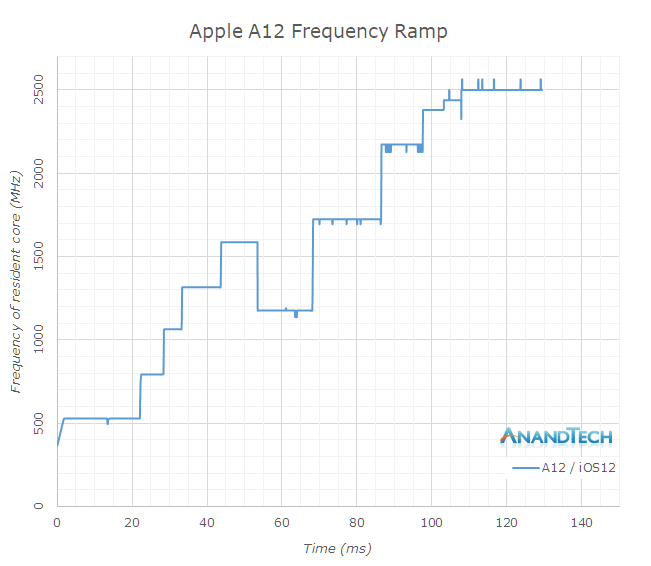The iPhone XS & XS Max Review: Unveiling the Silicon Secrets
by Andrei Frumusanu on October 5, 2018 8:00 AM EST- Posted in
- Mobile
- Apple
- Smartphones
- iPhone XS
- iPhone XS Max
System Performance
While synthetic test performance is one thing, and hopefully we’ve covered that well with SPEC, interactive performance in real use-cases behaves differently, and here software can play a major role in terms of the perceived performance.
I will openly admit that our iOS system performance suite looks extremely meager: we are only really left with our web browser tests, as iOS is quite lacking in meaningful alternatives such as to PCMark on the Android side.

Speedometer 2.0 is the most up-to-date industry standard JavaScript benchmark which tests the most common and modern JS framework performance.
The A12 sports a massive jump of 31% over the A11, again pointing out that Apple’s advertised performance figures are quite underselling the new chipset.
We’re also seeing a small boost from iOS 12 on the previous generation devices. Here the boost comes not only thanks to an a change in how iOS’s scheduler handles load, but also thanks to further improvements in the ever evolving JS engine that Apple uses.

WebXPRT 3 is also a browser test, however its workloads are more wide-spread and varied, containing also a lot of processing tests. Here the iPhone XS showcases a smaller 11% advantage over the iPhone X.
Former devices here also see a healthy boost in performance, with the iPhone X ticking up from 134 to 147 points, or 10%. The iPhone 7’s A10 sees a larger boost of 33%, something we’ll get into more detail in a little bit.
iOS12 Scheduler Load Ramp Analyzed
Apple promised a significant performance improvement in iOS12, thanks to the way their new scheduler is accounting for the loads from individual tasks. The operating system’s kernel scheduler tracks execution time of threads, and aggregates this into an utilisation metric which is then used by for example the DVFS mechanism. The algorithm which decides on how this load is accounted over time is generally simple a software decision – and it can be tweaked and engineered to whatever a vendor sees fit.
Because iOS’s kernel is closed source, we’re can’t really see what the changes are, however we can measure their effects. A relatively simple way to do this is to track frequency over time in a workload from idle, to full performance. I did this on a set of iPhones ranging from the 6 to the X (and XS), before and after the iOS12 system update.
Starting off with the iPhone 6 with the A8 chipset, I had some odd results on iOS11 as the scaling behaviour from idle to full performance was quite unusual. I repeated this a few times yet it still came up with the same results. The A8’s CPU’s idled at 400MHz, and remained here for 110ms until it jumped to 600MHz and then again 10ms later went on to the full 1400MHz of the cores.
iOS12 showcased a more step-wise behaviour, scaling up earlier and also reaching full performance after 90ms.
The iPhone 6S had a significantly different scaling behaviour on iOS11, and the A9 chip’s DVFS was insanely slow. Here it took a total of 435ms for the CPU to reach its maximum frequency. With the iOS12 update, this time has been massively slashed down to 80ms, giving a great boost to performance in shorter interactive workloads.
I was quite astonished to see just how slow the scheduler was before – this is currently the very same issue that is handicapping Samsung’s Exynos chipsets and maybe other Android SoCs who don’t optimise their schedulers. While the hardware performance might be there, it just doesn’t manifest itself in short interactive workloads because the scheduler load tracking algorithm is just too slow.
The A10 had similar bad characteristics as the A9, with time to full performance well exceeding 400ms. In iOS12, the iPhone 7 slashes this roughly in half, to around 210ms. It’s odd to see the A10 being more conservative in this regard compared to the A9 – but this might have something to do with the little cores.
In this graph, it’s also notable to see the frequency of the small cores Zephyr cores – they start at 400MHz and peak at 1100MHz. The frequency in the graph goes down back to 758MHz because at this point there was a core switch over to the big cores, which continue their frequency ramp up until maximum performance.
On the Apple A11 – I didn’t see any major changes, and indeed any differences could just be random noise between measuring on the different firmwares. Both in iOS11 and iOS12, the A11 scales to full frequency in about 105ms. Please note the x-axis in this graph is a lot shorter than previous graphs.
Finally on the iPhone XS’s A12 chipset, we can’t measure any pre- and post- update as the phone comes with iOS12 out of the box. Here again we see that it reaches full performance after 108ms, and we see the transition of the tread from the Tempest cores over to the Vortex cores.
Overall, I hope this is the best and clear visual representation of the performance differences that iOS12 brings to older devices.
In terms of the iPhone XS – I haven’t had any issues at all with performance of the phone and it was fast. I have to admit I’m still a daily Android user, and I use my phones with animations completely turned off as I find they get in the way of the speed of a device. There’s no way to completely turn animation off in iOS, and while this is just my subjective personal opinion, I found they are quite hampering the true performance of the phone. In workloads that are not interactive, the iPhone XS just blazed through them without any issue or concern.















253 Comments
View All Comments
name99 - Friday, October 5, 2018 - link
"I do hope Samsung and Apple alike would be able to focus more on optimising this, as like we’re about to see, it will have an impact on battery life."Presumably Apple's longer term plan (next year?) is to move to the LTPO technology in the aWatch4 display?
https://appleinsider.com/articles/18/08/24/future-...
https://www.reddit.com/r/apple/comments/9ga4wa/dis...
This appears to be an Apple specific (ie non-Samsung) tech, though who knows exactly what the web of patents and manufacturing agreements ultimately specifies...
SanX - Friday, October 5, 2018 - link
Similar to mobile processors performance surpassing some desktop ones, the mobile devices image quality also surpassing 5-7 years old DSLR tech. Your photo test suite would be great if it adds the Still Life, Resolution and Portrait tests from the pro photo testing sites like Imaging-resource dot com. I'd just send the phones to these folks and they do their tests so we would see the progress in comparison with all cameras of all times and manufacturers. Right now only the fields tests of Anandtech look poor and are not enough to tell what is good and what is missing in the cameras. Due to the great progress, the time for such new deep testing of mobile devices came right now.Pneumothorax - Sunday, October 7, 2018 - link
No way my Xs Max is touching my 10 year old D700 with a cheap $100 50 1.8 lens in anything over base iso. The iPhone starts applying some serious noise reduction at higher ISO’s making it watercolor like. Even at base iso, the D700 has much better fine detail.Constructor - Sunday, October 7, 2018 - link
Not to dispute your fundamental point (bigger lenses and bigger sensors can't really be replaced), but there are several low-light photo apps for the iPhone which support much longer exposure than the standard one and this can of course help at least with static images when you've got a fixed position for the iPhone.yvn - Friday, October 5, 2018 - link
I was surprised you said excellent viewing angle, I disagree! If you tilt the screen just a little up or down, left or right, the color changes a lot, it becomes more blue as you tilt more and I couldn’t get used to this so I returned the phone, my iPhone 7 Plus had no such behavior.Notmyusualid - Friday, October 5, 2018 - link
So... dual-sim finally (only phone type I buy), 4x4 MIMO, 7nm, but still no Android?!?Would it KILL Apple to offer an Android version, I mean really, would it? Even Sony broke in the end...
Guess they don't need my money, but nice handset, if a bit pricey.
cfenton - Saturday, October 6, 2018 - link
I can't tell if this is a serious comment. Apple makes something like 85% of the profit in the mobile phone market. They have absolutely no reason to even consider putting out an Android phone.Speedfriend - Tuesday, October 9, 2018 - link
Oh, that rubbish stat again. That is only in the narrowly defined mobile market. Apple makes its own OS, designs many of its own chips and controllers, sells its own insurance, runs its own app store and its own retail shops. It has many more parts of the overall value chain. For an accurate comparison, we would need to include what Qualcomm and Samsung make from SOCs, what Samsung and LG make from screens, what Samsung makes from memory etc.varase - Tuesday, October 23, 2018 - link
What, you kidding?I'm sure one reason for the push into custom silicon was because it was one thing Android OEMs couldn't copy.
Hifihedgehog - Saturday, October 6, 2018 - link
I am a little confused here by your rather bold assertion of desktop-class performance. Correct me if I am wrong, but aren’t the test results here for SPECint2006 inclusive of all cores whereas the Intel processor’s score you linked to is for a single thread. If so, then comparing six cores versus a single thread in a multithreaded desktop CPU is not very fair or valid. Again, I could be totally wrong but I just wanted to point this out.